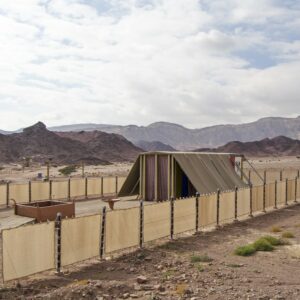 The Tabernacle was a wonderful place of mercy and forgiveness. However, this “tent” was not meant to be the source of deliverance for all time. The pangs that the Lord endured to deliver his redemptive plan are mind-boggling, especially when we read, “In the beginning was the Word, and the Word was with God” and “the Lamb was slain from the foundation of the world.” Paul penned, “And without controversy great is the mystery of godliness:” Perhaps we were just not ready to receive the fullness of His majestic Kingdom. Today, we read through the pages of the sacred manuscript and identify the types and shadows of Christ and His blueprint for reconciliation. I want to highlight examples from the tabernacle, priesthood, and sacrifices that reveal God’s grace.
The Tabernacle was a wonderful place of mercy and forgiveness. However, this “tent” was not meant to be the source of deliverance for all time. The pangs that the Lord endured to deliver his redemptive plan are mind-boggling, especially when we read, “In the beginning was the Word, and the Word was with God” and “the Lamb was slain from the foundation of the world.” Paul penned, “And without controversy great is the mystery of godliness:” Perhaps we were just not ready to receive the fullness of His majestic Kingdom. Today, we read through the pages of the sacred manuscript and identify the types and shadows of Christ and His blueprint for reconciliation. I want to highlight examples from the tabernacle, priesthood, and sacrifices that reveal God’s grace.
The first unmistakable piece of furniture seen upon entering the outer court was the brazen altar where priests shed blood for the atonement of sin. Why was blood required? “For the life of the flesh is in the blood,” and “without shedding of blood, there is no remission.” Jesus paid the debt owed by man’s sin with His sinless blood. On the “altar” of the cross, the perfect sacrifice for all time willing laid down His life “for the joy set before Him.” The altar was the most used item in the Tabernacle and is still available today with new mercies every morning!
The laver of water was positioned just outside of the holy place. The priests were to wash the blood they had on them, which mixed with the water in the laver. Nearing the end of the crucifixion, Jesus had His side pierced. From this wound, blood and water ran out; this was a “well-known symbol[s] of salvation to the Israelites.” Whereas the shedding of blood atoned for sin, the washing with water sanctified and cleansed. Now, we can relate an altar of repentance and water baptism with forgiveness and remission of sin. I have heard it preached many times that the blood of Christ gets applied during baptism. It is mingled in the water when we invoke the name of Jesus in baptism.
The dwelling of the holy place was to house the presence of God. John 1:14 declares that “the Word became flesh and dwelt among us.” Many translations use the translation of the word “dwelt” as “tabernacled.” Just as God dwelt among His people in a tent somewhat like theirs, Jesus would robe Himself in the flesh and walk this earth the same way we do today. “God with us” took on a whole new meaning when He sent His Spirit to live in us; “What? Know ye not that your body is the temple of the Holy Ghost which is in you, which ye have of God, and ye are not your own?”
There are too many examples to fit in this paper alone, but I would like to draw attention to the altar of incense. Prayer is such a vital part of our relationship with God. The Psalmist recorded, “Let my prayer be set forth before thee as incense;” The mixture of the incense has known ingredients and other ingredients called “sweet spices.” We understand many of the prayers that we should be praying: prayers of repentance, intercession, and thanksgiving. Perhaps the “sweetest” prayers are those birthed from times when we do not know what to say and allow the Spirit to “maketh intercession for us with groanings which cannot be uttered.” Jesus is our ultimate intercessor and advocate in this Dispensation of Grace. We should also openly live our Christian life in a good example: “For we are the sweet fragrance of Christ [which ascends] to God, [discernible both] among those who are being saved and among those who are perishing;” (2 Corinthians 2:15, AMP)
In conclusion, I have skipped over many pieces of the holy furniture and what they represent. We can find the totality of the symbolism in the Tabernacle, the priestly duties, and the sacrifices in the life-changing redemptive work of Jesus Christ. Everything points to Him! He came to fulfill the Law as the only begotten of the Father and the High Priest after the order of Melchizedek. The new covenant was established and paid for by the builder and maker! Jesus is the great architect of our salvation!